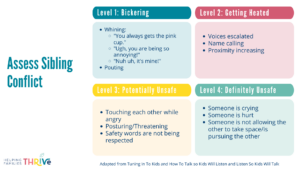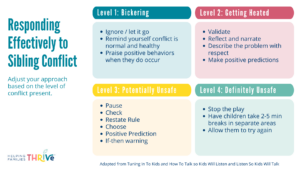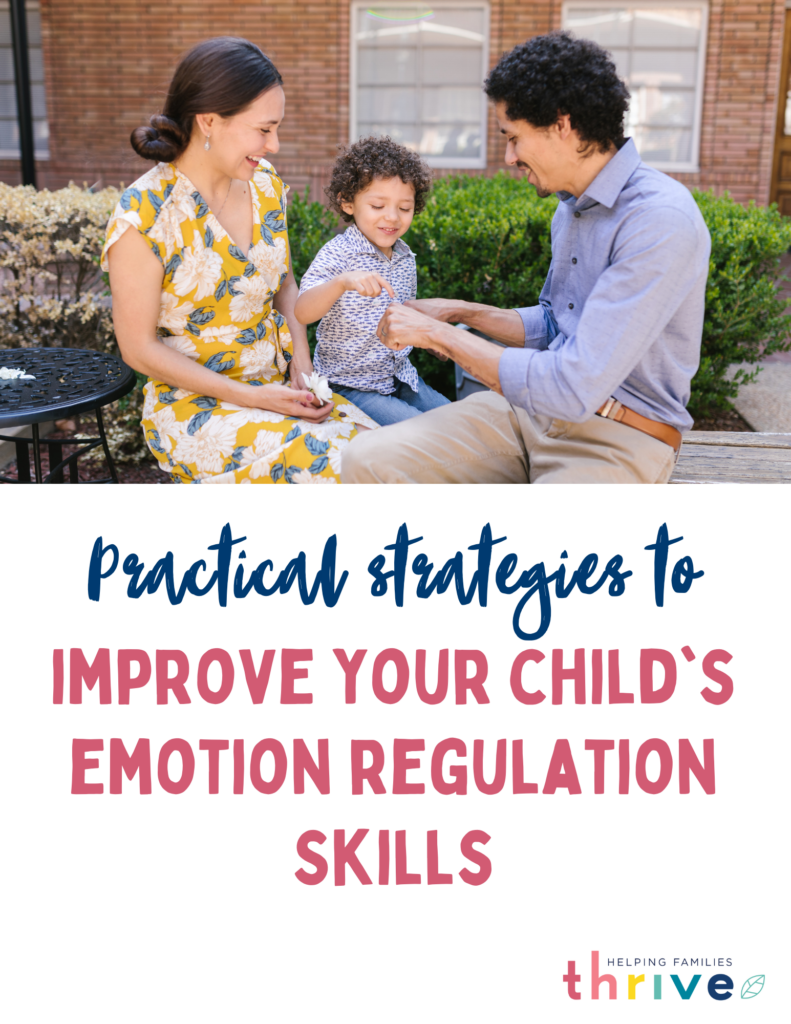Sibling conflict is normal! In fact, research finds that many parents identify sibling conflict as the most common problem in their families. For both of us, it’s one of our top triggers. Interestingly, we are both only children, so siblings battles were a harsh wake up call!
Here is what we remind ourselves and the families we see in clinic:
Sibling challenges provide repeated practice for navigating conflict. They are an opportunity to learn relationship strategies that children can use throughout their lives. Our goal is not to make conflict stop, it’s to make conflict skillful.
Does knowing that sibling battles are normal mean we let everything go? Nope. Research shows us that high levels of sibling conflict can lead to later increases in children’s anxiety, depressed mood, and delinquent behavior. Additionally, how parents respond to sibling squabbles really matters. Several studies (1, 2) have found that when parents are lacking effective skills for handling sibling conflict, kids are more likely to show difficulties in other areas of their lives as they get older. Importantly, there are specific parenting approaches that can help decrease the frequency and intensity of conflicts, while helping our kids build life-long relationship skills at the same time!
Spoiler alert: This framework involves a lot of parent self-regulation. To manage our kids in their big emotions, we have to first manage our own. Our kids are bringing ALL the heat…we don’t get to add to it! This is easier said than done. If you are used to your children’s “fun” horseplay turning into brawls and tears, then it is natural for us to become on edge the moment the “fun” begins. Our own dysregulation can then make us cut a potential learning opportunity short.
This is why having a concrete plan is so helpful. Just knowing you have a plan helps move parents from their “emotion mind” into a more regulated state, which in turn helps parents regulate their kids.
Here’s our 3 step plan for navigating sibling conflict.

Step 1: Pause & Assess
Not all sibling conflicts are created equal. We’re going to respond differently to bickering than we would to all out brawls! Before we teach you how to respond, we have to assess the situation. This assessment phase is a forced pause button.
Level 1: Sibling bickering
- Bickering, whining or complaining
- “You ALWAYS gets the pink cup.”
- “Ugh, you are being so annoying!”
- “Nuh uh, it’s MINE!”
- One sibling grabs a toy and the other starts pouting
Level 2: Heating up
- Voices escalating
- Name calling
- Proximity increasing
Level 3: Potentially unsafe
- Touching each other while angry
- Posturing/Threatening (e.g., cornering their sibling)
- Safety words are not being respected (e.g., “get out of my space bubble!” and sibling does not respond)
Level 4: Definitely unsafe
- Someone is crying
- Someone is hurt
- Someone is not allowing the other to take space/is pursuing the other
Step 2: Respond Based on Your Assessment

Level 1 Strategies
When things are emotionally and physically safe (as in sibling bickering), then our ONLY job is to regulate ourselves. If you feel pulled to do anything at all, find a positive behavior to praise within the bickering and then give space. This might sound like: “You really wanted to play with that one first. You’re being super calm while he takes a turn with it!”
Ignore, remind yourself this is healthy, praise positive behavior, and let go.
Level 2 Strategies
When voices start escalating and kids are getting closer while angry, you know things are heating up! Remember, heat does not mean things are on fire. You don’t need to rush in to fix, but rather calmly take the role of a sportscaster (NOT a referee).
- Acknowledge feelings (“I can see you’re both feeling upset.”)
- Reflect each perspective (“Tasha, you wanted a turn with the truck and feel upset that Sam grabbed it first. Sam, you also want a turn with that toy so you grabbed it.”)
- Name problem respectfully (“Both of you really want to play with that truck. That’s so tricky.”)
- Make positive predictions (“I bet you two can find a way to figure this out. If you want some help, you both know where to find me.”)
You do not need to go into extensive verbal processing here! Remember this mantra: “short and sweet means likely to repeat.”
Level 3 Strategies
Once kids start putting hands on each other or each other’s things, it’s time for us to intervene a bit more. In addition, it can be tough to differentiate horseplay from hurting. Plus, the line between play fighting and real fighting can get real fuzzy, especially as energy levels rise. This is where we have a powerful opportunity to give children the words to learn early consent.
- Pause: “Hey you two, pause (with hand signal). 2 steps back.”
- Check: “Let’s check on each other. Jojo your face looks excited, but check out your brother over here. Kayden, I can’t quite tell how you are feeling (modeling checking for nonverbal cues). Is this a play fight or a real fight? (giving vocabulary to differentiate).” Allow time for each child to respond.
- Restate rule: “Play fights are allowed, but real fighting and hurting is not.”
- Choose: “Okay, you both get to choose what and how you play. Kayden, do you want to keep doing this or choose something else? Jojo, how about you?”
- Predict: “OK! Sounds like you are both having fun and playing. I bet you guys will check in with each other and make sure it stays fun. I’ll be over here if you need me!”
- If-then: “If anyone gets hurt then you will need to take a break to get the energy back down.”
Tip: If one child is not having fun and chooses to move to something different. Quickly praise that child for speaking up (“No problem, I am SO glad you said something. You can always let people know when you’re not feeling good about play.”). Then praise the other child (“Jojo, you’re being an awesome little sister. You knew to pause to give him a minute”).
Level 4 Strategies
If tears are flowing or punches are flying it’s a hard stop. It’s so tempting to come in with a “who done it” approach, but this more than likely leads nowhere as both kids point fingers at each other and only escalate more. Instead, we focus on what to do NOW.
- If one person is clearly hurt, attend to that person first with brief validation and physical comfort if they want it.
- Then, state the blameless facts. “This got unsafe. You both need to take a short break (a few minutes) and then you can try again.” Taking a break can mean one of two things:
- Taking a break from the activity and choosing something else to do. This is appropriate if children do not seem escalated toward each other, but rather an activity (such as trampoline, playing a physical game, etc.) has repeatedly led to accidentally hurting because energy levels are too high. When energy is back down you can try again.
- Take a sibling break. This is helpful when things are escalated between the kids and time and space is needed. I can’t tell you how many parents report that their kids will be going at each other and then after just a 2 minute break they are itching to play together again! Time and space can really do wonders.
- Allow the kids to try again, while providing suggestions or problem solve how they might act more skillfully. “Alright, you can go play together again. Sarah, if you want something your sister has, what can you say? That’s right, you can ask her for a turn. What if she’s not ready to share, what can you do? Yep, you can come find me or play with something else.”
Note: Why are breaks so important? Breaks help build emotion regulation skills and are included in a variety of evidence-based interventions parenting programs. Additionally, short breaks are simply logical consequences.
Step 3: Get Curious and Teach Skills
Later, once your emotions have calmed, get curious. We want to ask ourselves questions to figure out what skill is missing. What are the common “triggers” for these behaviors in your child? Remember, behavior is communication and often communicates a missing underlying need or skill deficit. By zooming out and doing the detective work to decode your child’s behavioral communication, you can stop putting out fires and shift into prevention mode.
For example, you may learn that your child tends to hit when their sibling tries to take their toy from their hands. In this case, you will want to teach your kids (outside of heated moments) how to ask for a turn with their words as well as what to do if their sibling isn’t ready to share yet (find something else to do while they wait, etc).
Sometimes, we also might need to implement a bit of environmental structure for particularly sticky times. For example, if the trampoline is always leading to a brawl, a family rule may become that trampoline use is supervised by an adult while they are learning how to pause and check. This isn’t because the children are “in trouble” but rather because you want to help them get the skills they need to do this activity more independently and safely. Then, you might incorporate teaching the “pause and check” (described above) with your children as a coach during trampoline play and praise or reward positive sibling behaviors.
Final Thoughts
This framework for sibling conflict is consistent with the core tenets of evidence-based positive parenting, which is balancing both warmth and boundaries. It is also consistent with the 4cs of boundary setting.
Now, we have a crucial point to make here. We have been focusing ONLY on how to respond IN THE MOMENT of sibling conflict. But, the BULK of the work on anything child related is on the prevention and skill building side of things. For an overview of evidence-based prevention strategies plus more in depth information on the 3-step plan see our Sibling Conflict workshop here.
Remember, this parenthood journey is a wild ride and no two adventures look the same. Your journey make not look like your neighbor’s, your sister’s or your fave Instagram account. The best we can do is gather the best information available and use the tools the best we can. The most well-studied and effective tools aren’t particularly “sexy” or revolutionary sounding. They may not get a million followers, but they are feasible. They are tried and true and based on real families.
Does this mean everything is going to be kumbaya? No! Sibling dynamics are hard. Managing sibling dynamics if you have spicy or neurodiverse kids is even more complex! Focus on small, consistent, feasible steps. We mess it up. You will mess it up. It’s not about avoiding the blowouts, but about responding planfully and in ways that align with our values.
If you are ready to take this to the next step, take a peek at our Parenting Essentials Course.






